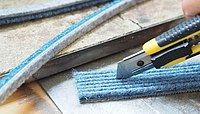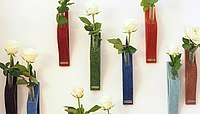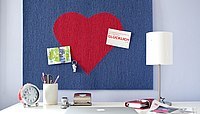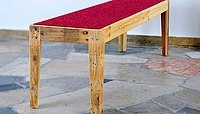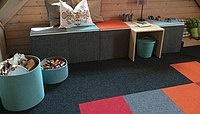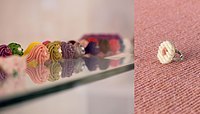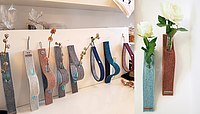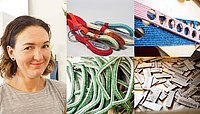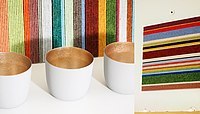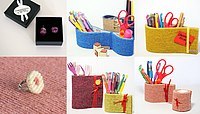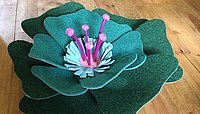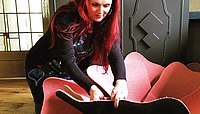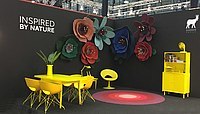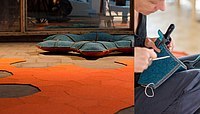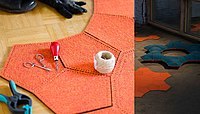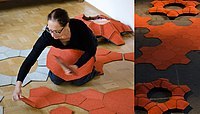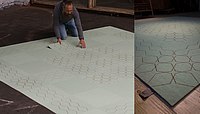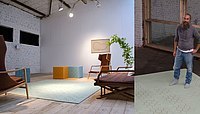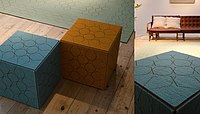Design with tretford
Material for creative individuals!
Carpeting by tretford is like no other. Its composition, its non-fray quality and the way it is manufactured is special – even one of a kind.
tretford doesn’t fray and this entices one to experiment with it.
Several designers have put their focus on this unique carpeting; they have put on display great creativity and a keen instinct for the material. And they have also found unexpected uses for it.
Gems
Tanja Hartmann, a graduate designer and goldsmith, very much appreciates the unique character of tretford carpeting.
She has used it over the past years for many new projects – from rings to wall vases and pictures that are exhibited at the Municipal Museum of Wesel (Städtischen Museum Wesel).
Tanja Hartmann comes up with ever new possibilities of combining it and assembling it into new contexts and new objects.
"The bold colors and unique structure of tretford carpeting inspires my creativity and gives me the drive to keep coming up with new designs and to keep putting the carpet into new contexts.
This, of course, is also conducive to discovering unique areas of application. I want customers to be delighted with my work but also want them to "use" it. I don’t create purely decorative articles; I create products that are purpose-oriented and beautiful," Tanja Hartmann elaborates in an interview.
Inspired by Nature
Another designer, Ingrid van der Veen, has also dealt extensively with the quality structure of this textile floor covering.
In fact, she designed a completely different kind of exhibition booth for a trade fair! She conceived an exhibition booth before which stunned visitors stop for a closer look.
Large, colorful hand-crafted flowers fashioned out of tretford carpet grace that walls of this exhibition booth.
Ingrid van der Veen loves colors. She always relies on her intuition and her individual designs have a graphic, colorful quality."My work emerges from my observations and careful listening. I very intuitively process the knowledge of my customers into harmonious compositions of color, form and materials".
In her capacity as art director, Ingrid van der Veen has already created designs for films and theater sets. Her atelier in The Netherlands, in close proximity to Zwolle, is a hub of creativity of a different kind.
Ruggls
Christiane Strauss, an illustrator, works in Cologne and Wuppertal. Having focused on sculpture and plastics during her art studies, she now puts spatial and physical aspects at center stage.
With her "ruggls" she conceived a bridge between seating furniture and floor covering using tretford carpeting.
She is inspired by nature for the simple components of her objects. The geometric pentagon modules, for example, are reminiscent of the shield-like cotyledon – or scutellum – of the common house fly. Placed front-to-front, the ribs recall the vascular tissue of a beech leaf.
For the designer, associating openly and freely is the first step towards a finished object. Strauss terms the development of a design as a "dialogical process".
"The material resists being a mere brainchild. You have to wrestle with it for it to divulge its true nature – and that’s when the dialog begins. That’s the greatest moment!"
Mathematical Structures
Frank Horlitz is an interior architect who creates geometrical light installations. He works with simple geometric structures that can be found in various cultures. "I pick up these lines and arrange them into new patterns based on mathematical operations," Horlitz suggests.
"I use these to superimpose the carpet’s signature ribbed structure and let it slip into the background. It doesn’t disappear though; the original character and optics is preserved."
The designer was intent on not adding anything to the natural pile material of the carpet. He thus opted for laser etching to convey the desired pattern onto the carpet.
In this context – his credo is "less is more". Minimalist patterns are used in order to retain as much of the surface, color and texture (as well as quality) of the original carpet as possible.
Several rotationally symmetric tile designs emerged from this. No matter how they are laid, they always fit. The various lasered carpet tiles permit endless combinations in the style of classic carpet designs (line/frame, decorative element).





